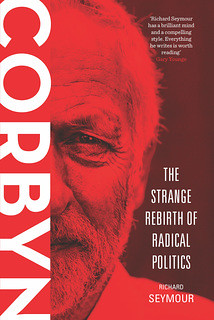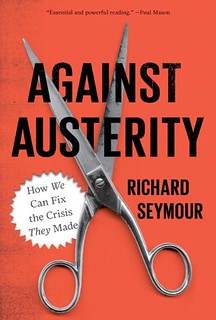Thursday, December 25, 2008
Racism after Obama. posted by Richard Seymour

I'm afraid I was too late with my entry to the ReadySteadyBooks symposium, but I did want to draw attention to David S Roediger's How Race Survived US History. It is an extremely timely argument about the enduring significance of 'race' in American society, as well as a sophisticated polemic against the complacent assumption that the Obama phenomenon spells the end of American racism. As the title implies, Roediger is interested not only in the origins of racism, and the way that it has been perpetuated and resisted, but particularly in how it managed to weather challenges, from the revolution to the civil war and 'jubilee', to the civil rights movement and its long-term results, including the election of Obama. After all, as he points out, "black males born 27 years after the most important civil rights acts, are estimated to have a 29% chance of imprisonment, more than seven times that of whites born in the same year". 224 years after the Declaration of Independence with its "created equal" clause, blacks and Latinos suffered poverty almost triple that of the white population. Over half a century after Brown v the Board of Education, 'apartheid schools' still flourish in America. Obviously race does matter, despite the emotional eulogies that followed Obama's victory.
To understand this, Roediger investigates the origins of 'possessive whiteness' as a legal and political doctrine that helped circumvent class struggle in the Virginia colonies and elsewhere, the Lockean arguments for slavery and colonialism, and the use of 'race' to manage and stratify the labour market. He takes issue with the simplistic arguments of the free market right, that racism was somehow inappropriate for capitalist development, acting as fetters to successful accumulation. According to the neoconservative canon, capitalism undermines racism by promoting abstract labour (everyone's muscle is the same regardless of skin pigmentation), and preferring supposedly more efficient free labour, But capital, Roediger notes, has profited most not by reducing the workforce to 'abstract labour' as per a certain blinkered marxist orthodoxy, but through the production of differences within labour - differences organised by gender, nation, race, and religion. This is crucial for the development of 'white republicanism', in which the egalitarian aspirations of white, working class Americans were successfully redirected into support for a hierarchical and exploitative system based on white supremacy. As for preferring free labour, slaver capital generated immense profit from the commodities whom they worked and traded. Northern capital also benefited, as did some of the North's elite universities. Northern liberals were as a result unwilling to seriously challenge that structure - so much so that in the early years of the Civil War, Lincoln insisted that defecting slaves were in fact nothing more than "contraband" who should be restored to their owners. It was only the pressures of military necessity on Lincoln, and a mass strike by slaves themselves, with some 200,000 of them leaving their erstwhile masters and rallying to the Union cause, that effecrtively guaranteed abolition.
Capital, north and south, would come to bitterly regret the experiment in democracy in the Reconstruction period. Though it was not possible to re-impose slavery, the new nationalism of the turn of the century did unite liberals and reactionaries in support of depriving African Americans of the vote (and thus of means to ameliorate their situation), and introducing segregation. There is, of course, a great deal of bad news for liberals in this book. Drawing partially on the work of Ira Katznelson, Roediger details the impact that official liberalism's collusion with white supremacy meant that federal programmes advocated under the New Deal were also means by which forms of segregation and deepening racial inequality were advanced. The racist components of the New Deal and, later, the Fair Deal are given a robust airing here. Even the exigencies of the Cold War, and the need to respond to decolonization, did not lead to mainstream liberals being willing to fundamentally challenge the one-party, racist southern power bloc until LBJ took bold measures that both abolished legal segregation and introduced reforms to undermine the poverty that, as he knew, was partly a legacy of past Democratic administrations. Though inherently self-limiting because these programmes depended on prolonged growth, and were deprived of the billions that were wasted on committing genocide in Vietnam, these reforms mattered enough that the Republican party made itself their most aggressive opponents. It was at this point that older racist discourses were re-coded in the language of the market, with welfare and affirmative action treated as 'reverse racism', as if existing inequality was meritocratic. Moreover, racial inequality was reinterpreted in terms of the mythology of the bootstraps, in which all immigrant groups in America do eventually embrace the American way of doing business, gain status and become mainstream: those that do not must be dysfunctional. It became an article of faith among rightward-moving liberals and the right, especially after Daniel Patrick Moynihan's report on inner city unrest, that black families lacked the virtues that made their white counterparts more efficient. Thus, a whole set of discriminatory practises in the economy and in criminal justice were naturalised as the efficient product of a free market and a just society, and by and large the Democrats capitulated to this discourse.
One odd weakness of the book is that the focus on domestic US history tends to leave the international, or rather imperial, component of American racism under-examined. Roediger is quite clear that racism was forged in a context of empire. However, the discussion of racism in US foreign policy, though by no means marginal to the topic, is rather slight in the book. A crucial aspect of liberal nationalism in the 'Progressive' era was the overcoming of American sectionalism by binding the Southern racial order to an imperial policy largely driven by Northern liberals. Roediger lucidly details the complex relationship between Cold War anti-communism and anti-racism, in a way that is much more sophisticated than Mary Dudziak's arguments. However, ne aspect of that anticommunism in power that Roediger overlooks was the way in which racist tropes permeated foreign policy thinking. One of the major headaches of post-war US governments was the achievement of what they frequently referred to as "premature independence". Eisenhower insisted that Arabs could not understand "our ideas of freedom or human dignity". This style of denigration returned in a 2003 State Department document which insisted that "the towel heads can’t hack" democracy. In this connection, it is surely telling that Obama has been more often vilified as an 'Arab' or a 'Muslim' than as an African American. Imperial culture must have a great deal to do with the survival of race in American history. Even with this caesura in mind, however, Roediger’s book provides a compelling and concise answer to the question of how race has persisted, and why it will survive the Obama phenomenon.
Labels: 'obamamania', class, david s roediger, imperial ideology, obama, race, racism, us working class










